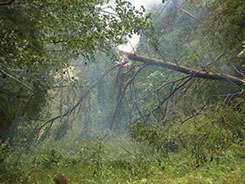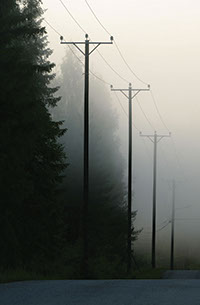


SEARCH MyCVEC
For Your Comfort and Convenience
When the Derecho hit Central Virginia on the last day of June in 2012, the weather was hot and the damage was considerable. People went in search of ice to keep food cool and hauled fuel to power generators for a limited amount of electricity. Living without electricity is difficult and attempting to replace it is expensive and labor intensive.
That is why one of your Cooperative’s top priorities is reliable service. We even have a department of people who work on that every day so that you don’t have to … and they have a pretty good strategy:
1. Keep the lights on by reducing faults.
2. Limit the impact when faults do occur.
3. Respond and repair as quickly as possible.
![]()
1. Keeping the lights on by reducing faults:
 Most outages on the CVEC system are caused by trees growing outside of the 40-foot power line right of way (ROW) that fall into the ROW and onto or through the power lines. No longer isolated and insulated, the trees provide a path to ground for the electricity, which creates a short circuit.
Most outages on the CVEC system are caused by trees growing outside of the 40-foot power line right of way (ROW) that fall into the ROW and onto or through the power lines. No longer isolated and insulated, the trees provide a path to ground for the electricity, which creates a short circuit.
In addition to our regular ROW maintenance work ($1.6 million annually) CVEC has added some new activities to keep the lights on:
- Increasing the pace and scope of ROW work, including removing dead or diseased danger trees growing beyond the ROW (with the property owner’s permission).
- Clearing single-phase lines and ensuring that lateral branch growth is trimmed in a timely manner.
- Adding wildlife protectors.
- Improving grounding where necessary and adding lightning arrestors.
- Utilizing vegetation management software and distribution system monitoring to track and analyze our efforts compared to incidents and outages.
Of the three strategies, keeping the lights on provides the greatest benefit to members, receives the majority of investment, and it is something that we work on every day.
![]()
2. Limiting the impact when faults do occur:
 With 4,500 miles of power line flowing through rolling to rugged rural terrain, it should come as no surprise that trees are far and away the number one cause of outages, often in combination with a weather event. After trees, outages occur as a result of animals/birds, lightning, equipment failure, and actions by the public (auto accidents, tree cutting, farm equipment, etc.)
With 4,500 miles of power line flowing through rolling to rugged rural terrain, it should come as no surprise that trees are far and away the number one cause of outages, often in combination with a weather event. After trees, outages occur as a result of animals/birds, lightning, equipment failure, and actions by the public (auto accidents, tree cutting, farm equipment, etc.)
CVEC is working to increase the number of protective devices located along the distribution line to isolate faults when they do occur.
This includes:
- putting fuses at the take-off point on all single-phase “tap lines.”
- segmenting three-phase lines with protective equipment that will isolate the fault and keep as many people in service as possible.
- looking for opportunities to construct alternate paths to back-feed power.
While fewer in frequency, when one of the transmission line companies drops the power feed to a CVEC substation, every member is instantly out of service and will be until service is restored by the Investor-Owned Utility that delivers energy to the CVEC distribution system.
![]()
3. Respond and repair as quickly as possible:
Too late! Snow falls, winds rage, trees topple, and the lights go out. Despite all of the planning and best efforts, outages will occur, particularly in Cooperative territories that have radial lines. Radial lines stretch from the substation, delivering electricity out to the end of the circuit, branching off as they go, with no alternate source of power. One downed tree may affect hundreds of members or it may affect half a dozen members. After a major weather event, there may also be hundreds of trees down that need to be cleared before all members will have service restored.
CVEC has worked to establish a quick response and repair process, including:
- positioning linemen prior to a major storm with stocked vehicles and rallying volunteer linemen from other states ready to pitch in.
- taking what the system gives you. Since the primary (three-phase) circuits feeding out of the substations provide energy to all single-phase lines located farther down line, clearing the primaries first is logical and necessary. This step permits the most members to see power restored as soon as possible (typically over 50% in the first 24 hours … see the chart below).
-

- working with information provided by members to the CVEC Outage Management System, which will predict the fault location that will be found down line from a protective device, such as a recloser, that operated when the fault happened and turned off the power to prevent further damage.
- keeping members and community leaders informed about the process of and the progress with repair efforts. Look for an updated outage web map with greater detail before the end of the year.
![]()
Keeping the lights on . . .
minimizing the impact and responding to outages
so members enjoy the good value of
comfort and convenience powered by electric energy.
HOME | REPORT AN OUTAGE | PAY MY BILL | CONTACT CVEC
Phone: 434.263.8336 | Toll free: 800.367.2832 | Fax: 434.263.8339
Corporate Headquarters:
800 Cooperative Way
Arrington, VA 22922
Payments:
Dept. 1340 | PO Box 2153
Birmingham, AL 35287-1340
Correspondence:
P. O. Box 247
Lovingston, VA 22949
